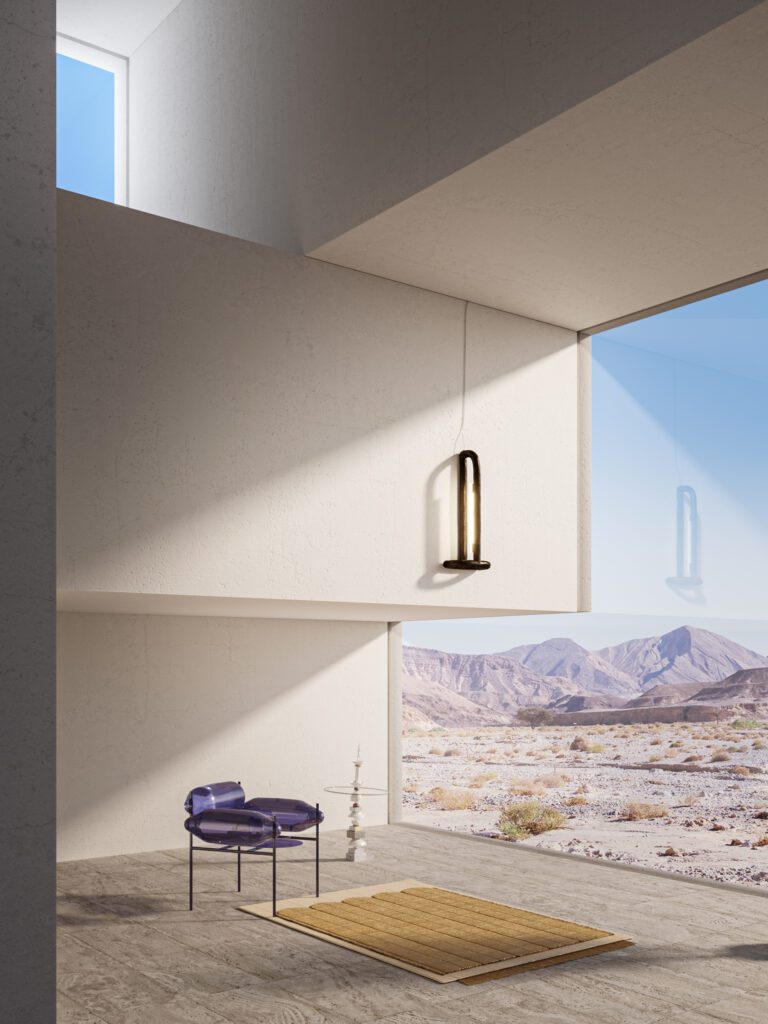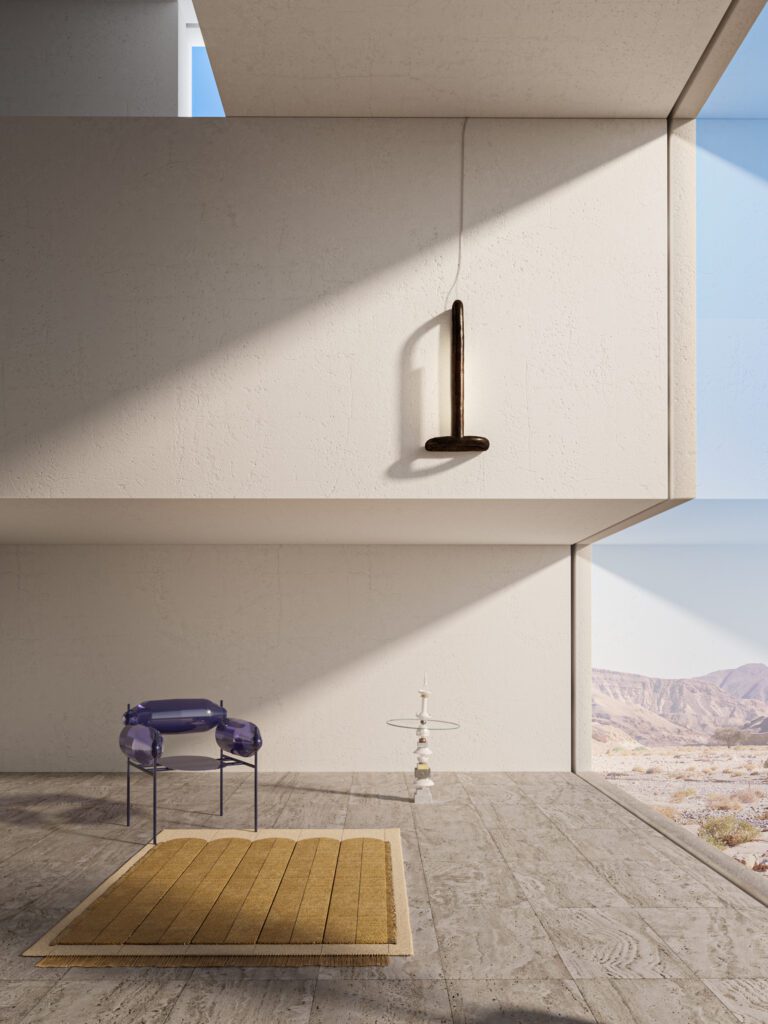

Is it Real?: 3D Rendering in the Design Industry
You have probably found yourself scrolling through your social media feed and come across something that might have looked a bit too impossible to be true. You question – is this real?
To explore the world of 3D rendering and its uses in the collectible design industry, Adorno has teamed up with a diverse group of fourteen 3D artists, a rare breed of tech-savvy aestheticians, to interpret a range of pieces in their imaginative environments. These independent artists are receiving a vast amount of attention across social media platforms – for good reason! There are endless possibilities in this space, allowing artists and designers free rein when it comes to design and scenography.
In the realm of collectible and interior design, 3D rendering offers a new level of visuality and connection between pieces and the spaces they could inhabit. These virtual environments, despite their imaginative aesthetics, allow us to understand how a piece will translate to a more familiar space. At the same time, there is a sense of escapism, bringing us on a journey into the 3D artist’s highly aesthetic world.
All visualisations are courtesy of the artists. All product images courtesy of the designers.
Jesús Mascaraque (IG: @mascaraque_)
Often set in spaces filled with warm, calming colours and waning afternoon light, Jesús Mascaraque’s digital environments present a realistic, yet dream-like world. Dubbed as “visual explorations”, these renderings are a visual treat that brings together minimalistic, idyllic settings with contemporary design.














Another Artist (IG: @another_a_r_t_i_s_t)
With the rise in the use of digital environments and 3D rendered pieces, Another Artist explores the possibilities of design and architecture through the creation of surreal and striking scenes.
Commissioned by high-end furniture brands and new projects like Movimento Club, Another Artist creates everything from simple spaces to cinematic landscapes, an experimental approach allowing endless opportunities.
















Mercedes Luna Larrahona (IG: @merlarrahona)
A dreamy, beachside aesthetic characterises Mercedes Luna Larrahona’s approach to 3D rendering. Curving lines, patterning, and gentle hues of blue and white place the viewer in her digital world, in which she explores spaces and shapes through illustration, sculpture, and 3D.




L-R: Sisse Lee, “Class L” Vase I; Evelina Kudabaite, “Raituzai” Mirror – Large; Tartaruga Studio, “Spot” Set of Kilims; Anton Mikkonen, “Udon” Stool; & The Whole Elements, “Shape N.1” Room Screen
Sebastien Baert (IG: @sebastien.baert)
Both a 3D artist and industrial designer, Sebastien Baert’s focus on simple aesthetics and minimalistic scenes bring a great sense of realism to his work. Form, light, and material evidences Baert’s attention to detail and interest in the reinterpretation of objects and environments.


Karl Larsson (IG: ninesidedshape) & James Tralie (IG: james_films)
Karl Larsson’s world of pastel pink and blue presents the playful side of 3D rendering. A candy-coloured, dream-like scenography transports the presented pieces to a new level of reality and pushes the boundaries of virtual design.
Exotic destinations and otherworldly spaces become familiar in James Tralie’s 3D scenes. In his latest project, “The Great Indoors”, which he began exploring during quarantine, Traile brings his favourite destinations to interior spaces and creates a beautifully aesthetic world which viewers can digitally escape into.




Gamification & Real-Time Rendering
Coming out of the world of gaming, real-time rendering produces scenes as if in “real-time”, quickly and efficiently, while maintaining a hyper-realism. It allows for interactions to be made between the viewer and the scene, playing into a notion of gamification. The immediacy of this approach becomes almost life-like, with the virtual world adjusting to different materials, lighting, and angles as if the viewer is actually present in the space.
3D artists like Secondary Bounce, as seen below, have utilised real-time rendering to help in the development of interactive walkthrough scenes featuring architectural proposals, interior design, and product development. The speed and realism of these scenes allows changes to be made almost instantly, effectively communicating exactly how a space or object will look.
Virtual Design Destination
Working with the skilled team of Milan-based 3D developers from Myd3sign, Adorno’s own foray into the world of 3D rendering and digital environments came in the form of the Virtual Design Destination, part of London Design Festival 2020. It was the premier destination to discover curated collectible design during the Festival, 12-20 September, and featured more than one-hundred independent designers from fourteen countries. The exhibition investigated the theme of “the New Reality”, asking the participating curators to reflect on specific experiences, thoughts, and themes from the time of lockdown in the curation and art direction of each of their country collections.








Adorno partnered with the pixel streaming platform Furioos to provide real-time rendering from any browser or VR headset, making it possible for visitors to freely navigate around immersive, country-specific environments to experience the collections that have all been modelled in 3D. In this way, visitors were able to explore the collections in a similar, yet different fashion to attending the London Design Festival in previous years. The interactivity of the spaces and connection to the designers allowed for up-close encounters with the pieces and a more intimate understanding of the design processes behind them.
Secondary Bounce (IG: @secondarybounce)
Mauro Muñoz & Miguel Segovia of the 3D design studio Secondary Bounce make use of real-time rendering in their work, creating hyper-realistic scenes that allow viewers to explore the architecture and design pieces within them. Their latest project, a virtual reality app called “The Appartment”, makes use of their realistic aesthetic and real-time rendering to bring viewers through a living space, interacting with objects, materials, and lighting via different visualisation methods, including virtual reality.
Gonzalo Miranda (IG: gonzzzalo.m)
Playful scenes and realistic objects characterise Gonzalo Miranda’s 3D design work. His background in graphic design and work as an art director is evident in the way he creates a scene, from the intriguing composition to the use of bold colours to dramatic lighting.


Thomas Dreux (IG: @dreux_thomas)
3D rendering allows spaces come to life with attention to lighting, form, and materiality in a way that 2D photography cannot capture. In Thomas Dreux’s work, bold colour and unexpected forms create a digital aesthetic somewhere between reality and otherworldly. Recognisable spaces take on an intriguing twist that allows Dreux to explore the possibilities of his digital world.




Nicholas Preaud (IG: @ni.acki)
Based in Paris, Nicholas Préaud & Cyprian Chojnacki focus their work on architecture and product design. Their hyper-realistic works visualise spaces and give a sense of tactility to the pieces presented within them. With the flexibility of 3D rendering, their work allows for design developments that are beyond the scope of traditional photography.


Nicole Wu (IG: @nicolemadethat)
With a focus on narrative and emotion, 3D artist Nicole Wu creates scenes with transport viewers to a calm and relaxing, yet dreamy setting. Her work plays with the balance of reality and the surreal, often combining lush, vacation-worthy locales with whimsical elements. Wu’s aesthetic instantly identifies her work, transporting us to her world of relaxing aesthetics.


Martin Schropp (IG: vyoviz)
A clear narrative and minimalism rein free in Martin Schropp’s 3D visualisations. His attention to detail and knowledge of how architecture and design work alongside each other allows for the development of hyper-realistic scenes that mimic photography. Schropp’s work is a clear example of how well 3D rendering can be used to showcase contemporary collectible and interior design.
The Rise of the use of 3D in the Design Industry
Will there be no need for a camera crew and set designers anymore? With 3D imaging of pieces and rendering of scenes, the opportunities for visualising an object or space are only restricted by the imagination of the artist.
In addition to images taken by a photographer of a piece from all of the best angles, 3D rendering allows pieces to be placed in a space and give an idea of how they connect with other pieces of furniture. Whether this space is realistic and homely or otherworldly and experimental, these images give an extra layer of context and tacility. Via virtual reality, 3D rendering can also provide viewers with the opportunity to place objects in their own homes, giving them an idea of exactly how an object will look in their space before they decide to purchase it.
The possibilities of virtual environments are endless. This can be seen in the case of Adorno’s Virtual Design Destination, which presented collections in fourteen different country-specific settings including the rolling dunes of the Lithuanian seaside at Curonian Spit, an underwater Finnish scenography, a Norwegian artist’s studio, and the Museo Nacional de Arte Romano in Spain, among many others. Settings are limited only by the imagination of the artist and the pieces which will inhabit them.
LAVS (IG: @lavs.uk)
London-based digital agency LAVS creates hyper-realistic imagery with a focus on architecture and visual arts. Rich colours, tactile objects, and luxurious settings evidence the abilities of 3D rendering to create an all encompassing and visually intriguing setting.




Loay Altal (IG: @loayaltal)
Amman-based 3D artist Loay Altal brings his background in architecture and photography into the virtual world. The built environment is highlighted through an attention to detail and an eye for realism, developed through his work as an architectural photographer. The real and the virtual come together to create familiar, welcoming spaces from a new perspective.








